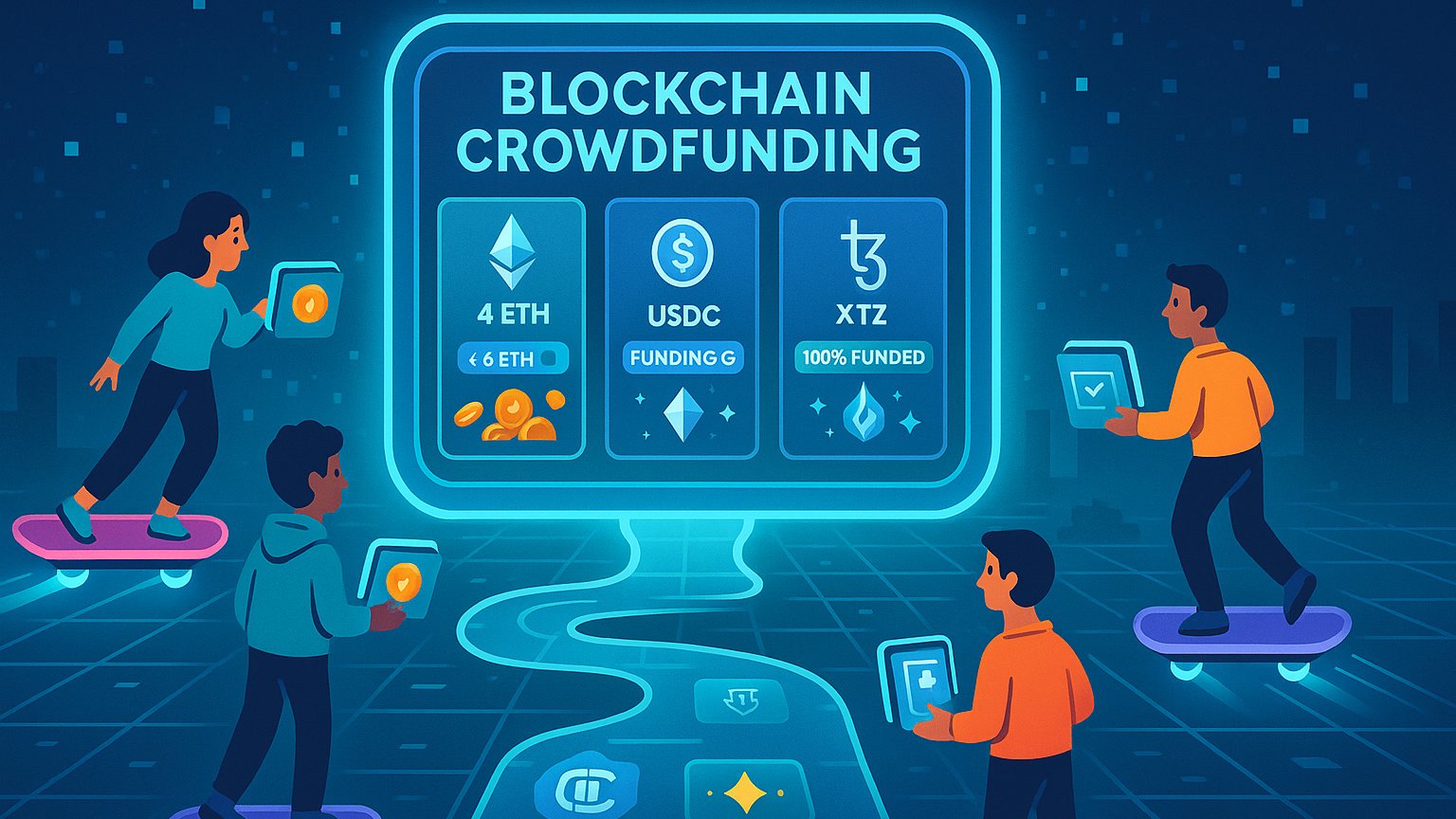Blockchain and Token Crowdfunding: Redefining Ownership and Opportunity in the Web3 Era
Crowdfunding has evolved from online donation jars to digital venture capital—borderless, decentralized, and instant. At the center of this transformation is blockchain and token crowdfunding, a powerful fusion of finance and technology that allows creators to raise capital using cryptocurrencies, while investors earn tokens that can represent utility, governance, or real-world value.
This isn’t just another fundraising model—it’s a paradigm shift. Through blockchain, trust is distributed across code, communities become stakeholders, and global funding becomes borderless and inclusive. From launching new Web3 startups to fueling the next decentralized social network, blockchain-based crowdfunding is fueling innovation with unprecedented speed and scale.
This pillar guide explores the entire ecosystem—whether you’re a creator seeking to launch a token sale, an investor curious about the risks and rewards, or someone trying to understand how ICOs, IDOs, and smart contracts fit into this fast-moving world. The blockchain funding frontier is wide open. Let’s dive in.

Investors in Block Chain and Token Crowdfunding
Welcome to the cutting edge of investing—where blockchain meets crowdfunding, and tokens unlock entirely new ways to grow your portfolio. As an investor, you’re no longer limited to traditional shares or bonds. Tokenized crowdfunding lets you back startups, real estate, art, and even entertainment projects through secure, blockchain-based assets. These digital tokens often come with real utility, revenue-sharing potential, or future tradeability, offering dynamic ways to diversify and capitalize on

Creators in Block Chain and Token Crowdfunding
Welcome to the future of fundraising—where creators harness the power of blockchain and tokens to launch, scale, and sustain groundbreaking projects. Blockchain and token crowdfunding allows you to raise capital from a global audience while offering supporters something far more powerful than a perk: a digital asset with built-in value. Whether you’re developing a game, launching a tech product, producing media, or building in Web3, tokens turn your community into

Web3 Models in Block Chain and Token Crowdfunding
Web3 is flipping the script on how ideas are funded, built, and owned—and blockchain and token crowdfunding models are at the heart of this revolution. In the world of Web3, creators and communities work hand in hand, using smart contracts, DAOs, and token economies to bypass traditional gatekeepers and fuel innovation from the ground up. Crowdfunding is no longer just about collecting donations—it’s about empowering backers to become participants, collaborators,

Platforms in Block Chain and Token Crowdfunding
Ready to explore the platforms that are redefining how creators raise capital and how investors build portfolios? Blockchain and token crowdfunding platforms are the engines of the decentralized funding revolution—each with unique features, funding models, and token strategies. Whether you’re launching an NFT collection, raising for a DAO-powered project, or investing in tokenized assets, understanding the platform landscape is key to your success. This section is your hands-on guide to

ICOs, IDOs, and IEOs in Block Chain and Token Crowdfunding
Welcome to the launchpad of blockchain fundraising—where ICOs, IDOs, and IEOs offer creators and investors bold new ways to fund innovation and fuel growth. These token sale models are the rocket boosters of the Web3 economy, each offering distinct advantages in how tokens are launched, distributed, and supported. From the wild frontier of ICOs to the structured safety of IEOs and the decentralized dynamism of IDOs, this is where new

Tokenomics in Block Chain and Token Crowdfunding
Behind every successful blockchain project is a powerful combo of tokenomics and smart contracts—the engines that drive trust, transparency, and real-world utility. Tokenomics defines how your digital assets work: how they’re distributed, what they’re worth, and how they incentivize behavior. Smart contracts bring that vision to life, automating agreements, payouts, and governance with precision and zero middlemen. Whether you’re launching a crypto-powered startup or investing in one, understanding these core

Wallets and Crypto Payments in Block Chain and Token Crowdfunding
In the world of blockchain and token crowdfunding, your wallet is more than just a storage tool—it’s your gateway to funding innovation, managing digital assets, and participating in the Web3 economy. Whether you’re launching a tokenized project or investing in one, wallets and crypto payments are at the core of every transaction. From securing tokens to sending funds across the globe in seconds, understanding how wallets work is essential to

Legal and Regulatory Landscape in Block Chain and Token Crowdfunding
The blockchain world moves fast—but the legal and regulatory landscape is what keeps it grounded, fair, and sustainable. For creators launching token-based campaigns and investors entering digital markets, understanding the legal framework isn’t just smart—it’s essential. From securities laws and KYC/AML compliance to global jurisdictional nuances, the rules of blockchain crowdfunding are complex, evolving, and crucial for long-term success. Getting it right means protecting your vision, your capital, and your
For Investors: Owning the Future, One Token at a Time
For investors, blockchain crowdfunding opens up an entirely new asset class: digital tokens tied to early-stage projects. It’s like getting equity in a startup, governance in a protocol, and utility in a decentralized app—all wrapped into one cryptographic token. Investors participate in initial token offerings by exchanging stablecoins or native cryptocurrencies like Ethereum or Solana. In return, they receive project tokens that may grant them access, voting rights, rewards, or future profit-sharing. Some tokens even trade on decentralized exchanges (DEXs), giving early investors potential liquidity and upside.
But blockchain investing requires sharp eyes and due diligence. For every moonshot, there’s a rug pull or vaporware. Investors must assess whitepapers, check smart contract audits, vet the team, and understand the tokenomics before buying in. Still, the potential is huge. Imagine being an early backer of Ethereum, Solana, or Filecoin through their original token sales. The risk is real—but so is the opportunity to be on the front lines of innovation.
For Creators: Empowering Builders with Decentralized Capital
In traditional fundraising, creators had to pitch to gatekeepers—banks, VCs, or incubators—just to get a foot in the door. Blockchain flips the script. Now, anyone with a strong project and a compelling whitepaper can tap into a global network of crypto investors ready to fund innovation through token sales. For creators, token crowdfunding isn’t just about money—it’s about community. Every token sold is a stake in the future of the project. It creates alignment between builders and backers, turning early supporters into promoters, users, and in some cases, co-governors of the platform.
Web3 creators can use token sales to build DAOs (Decentralized Autonomous Organizations), fund NFT projects, or bootstrap decentralized protocols without relying on centralized exchanges or traditional finance. With smart contracts handling the flow of funds and token distribution, the process becomes faster, more transparent, and programmable. To succeed, creators must communicate their vision clearly. That means building a whitepaper that outlines token utility, governance structure, team experience, and a roadmap that inspires confidence.
Web3 Models: DAOs, NFTs, and Protocols Fueling the Ecosystem
Web3 isn’t just a buzzword—it’s the backbone of blockchain crowdfunding. The decentralized internet relies on models where users own a piece of what they build and use. That ownership often starts with token sales. Decentralized Autonomous Organizations (DAOs) are community-led groups where decisions are made by token holders. Crowdfunding for DAOs typically involves token distributions that double as voting rights. Backers don’t just fund the project—they help govern it.
NFT-based crowdfunding has also exploded. Artists, game developers, and content creators use NFT drops as a fundraising mechanism, granting access to exclusive content, metaverse assets, or real-world perks. These aren’t just digital collectibles—they’re programmable membership passes with long-term value. Protocol tokens, like those used in DeFi platforms, govern everything from yield farming rewards to liquidity incentives. Token crowdfunding enables protocol builders to raise funds from their future users—aligning incentives from day one.
Web3 models prioritize decentralization, transparency, and incentive alignment. That’s why blockchain crowdfunding isn’t just raising capital—it’s building ecosystems.
ICOs, IDOs, and IEOs: Understanding the Alphabet Soup of Token Launches
When it comes to launching a token, creators have several options—each with its own strengths, risks, and technical considerations.
Initial Coin Offerings (ICOs) were the original token sale model. Popularized in 2017, ICOs allowed projects to raise funds directly from the public by selling tokens in exchange for cryptocurrency. While revolutionary, ICOs faced criticism for lack of regulation and investor protections.
Initial Exchange Offerings (IEOs) moved token sales onto centralized crypto exchanges. Projects benefit from exchange vetting and liquidity, while investors gain a layer of trust and simplicity. However, listing fees and centralized control can be a drawback for purists.
Initial DEX Offerings (IDOs) represent the decentralized future. Projects launch tokens directly on decentralized exchanges like Uniswap or PancakeSwap, using smart contracts to manage the sale. IDOs offer transparency, accessibility, and immediate liquidity—but require strong community marketing and smart contract expertise.
Choosing the right launch model depends on the project’s goals, audience, regulatory posture, and development stage. ICOs offer control, IEOs offer exposure, and IDOs offer decentralization.
Platform Walkthroughs: Where Blockchain Crowdfunding Comes to Life
Token crowdfunding platforms offer the infrastructure for creators to launch and manage token sales while guiding investors through discovery and participation. These platforms serve as the new frontier for crypto funding.
CoinList is a leading platform for curated token sales. It helps top-tier projects like Solana and Mina Protocol raise capital from a vetted global community of crypto investors.
DAOstarter and Polkastarter specialize in launching decentralized IDOs across multiple chains, offering cross-chain liquidity, early access for stakers, and community-driven campaigns.
KickPad and TrustSwap provide smart contract-based launchpads with anti-rug pull features, token locks, and token vesting automation to protect both creators and investors.
Republic Crypto, an arm of Republic.co, is bridging the gap between traditional investors and Web3 by offering compliance-first token sales and tokenized equity blends.
Platforms vary in their features—some offer fiat on-ramps, investor whitelisting, built-in wallets, or access to incubators. Understanding platform fees, token vesting timelines, investor protections, and reputation is key to choosing the right one.
Tokenomics and Smart Contracts: The Logic That Powers It All
Tokenomics is the economic design behind a token—how it’s distributed, used, and valued. Smart contracts are the engine that makes it run. Together, they define the success or failure of a token project.
A well-designed tokenomics plan answers essential questions. How many tokens will exist? Who gets them and when? Are they inflationary or capped? What drives demand? How are early contributors and backers rewarded without oversaturating the market?
Token utility is also critical. Does the token unlock access? Enable transactions? Power staking or yield farming? Or offer governance rights in a DAO? The more integrated the token is in the product’s value cycle, the stronger its long-term outlook.
Smart contracts ensure these rules are followed automatically. They manage token issuance, transfers, vesting schedules, and investor payouts. Unlike traditional crowdfunding, you don’t need a central administrator—just secure, audited code.
Many teams hire third-party auditors like Certik or Quantstamp to review smart contracts and provide security certification. This builds trust and prevents exploits.
Tokenomics is both art and science. The best projects find a way to balance fairness, reward participation, and create sustainable ecosystems.
Legal and Regulatory Landscape: Navigating Compliance in a Decentralized World
Token crowdfunding exists at the edge of innovation—and regulation. Understanding the legal framework is essential for both creators and investors. In the United States, the SEC views many token sales as securities offerings. Projects using token crowdfunding may need to comply with Regulation D, Regulation S, or Regulation A+, especially if raising from U.S. investors. This means filing disclosures, restricting investor types, and limiting marketing practices.
Outside the U.S., regulation varies. Some countries embrace crypto innovation with open arms—like Switzerland or Singapore—while others impose strict controls or outright bans. One strategy for compliance is the use of utility tokens—tokens that serve a functional role in an ecosystem and are not meant as investments. However, the line between utility and security is often blurry and hotly debated.
Legal wrappers like SAFT (Simple Agreement for Future Tokens) allow projects to raise money legally while deferring token issuance. Some platforms offer built-in compliance tools, KYC/AML procedures, and legal counsel to help navigate complexity. Regulatory clarity is evolving fast. Smart creators and investors follow developments, use compliance-friendly platforms, and consult legal experts before making major moves.
Wallets and Crypto Payments: Powering Participation Across Borders
Participation in blockchain crowdfunding requires digital tools—crypto wallets, payment gateways, and sometimes even gas tokens to cover transaction fees. Fortunately, getting started is easier than it seems.
Wallets like MetaMask, Trust Wallet, and Coinbase Wallet allow users to store and manage tokens, connect to crowdfunding platforms, and sign smart contracts. They also offer backup keys, password recovery, and support for multiple blockchain networks. Investors typically fund their wallets using stablecoins like USDC or native tokens like ETH, SOL, or BNB, depending on the platform. These are used to purchase project tokens directly in token sales.
For security, users should store their tokens in non-custodial wallets, enable two-factor authentication, and avoid phishing links. Hardware wallets like Ledger and Trezor add an extra layer of protection. Many platforms now offer fiat on-ramps and off-ramps, allowing users to buy tokens using a credit card or bank transfer. Still, blockchain-based crowdfunding thrives on decentralization—so getting comfortable with crypto wallets is key to fully participating.
Digital payments have never been faster or more inclusive. With just a wallet and a little crypto, anyone can back the next big innovation from anywhere on Earth.
The Token-Fueled Future of Crowdfunding
Blockchain and token crowdfunding is more than a trend—it’s the foundation of a new financial era. It’s fast, transparent, and inclusive. It lets creators raise capital without borders. It turns users into stakeholders. It rewards participation with ownership.
This model empowers entrepreneurs in Nairobi, musicians in Berlin, and protocol builders in Seoul to access capital from believers around the globe. It enables fans, gamers, and crypto enthusiasts to support projects they love—and profit from their growth. Whether you’re minting a new DAO, funding a Web3 game, or looking to invest in the decentralized web, token crowdfunding is your toolkit for innovation. It merges technology with community. It replaces paperwork with code. And it turns every project into a shared journey.
The gatekeepers are gone. The crowd is sovereign. The future is tokenized.

